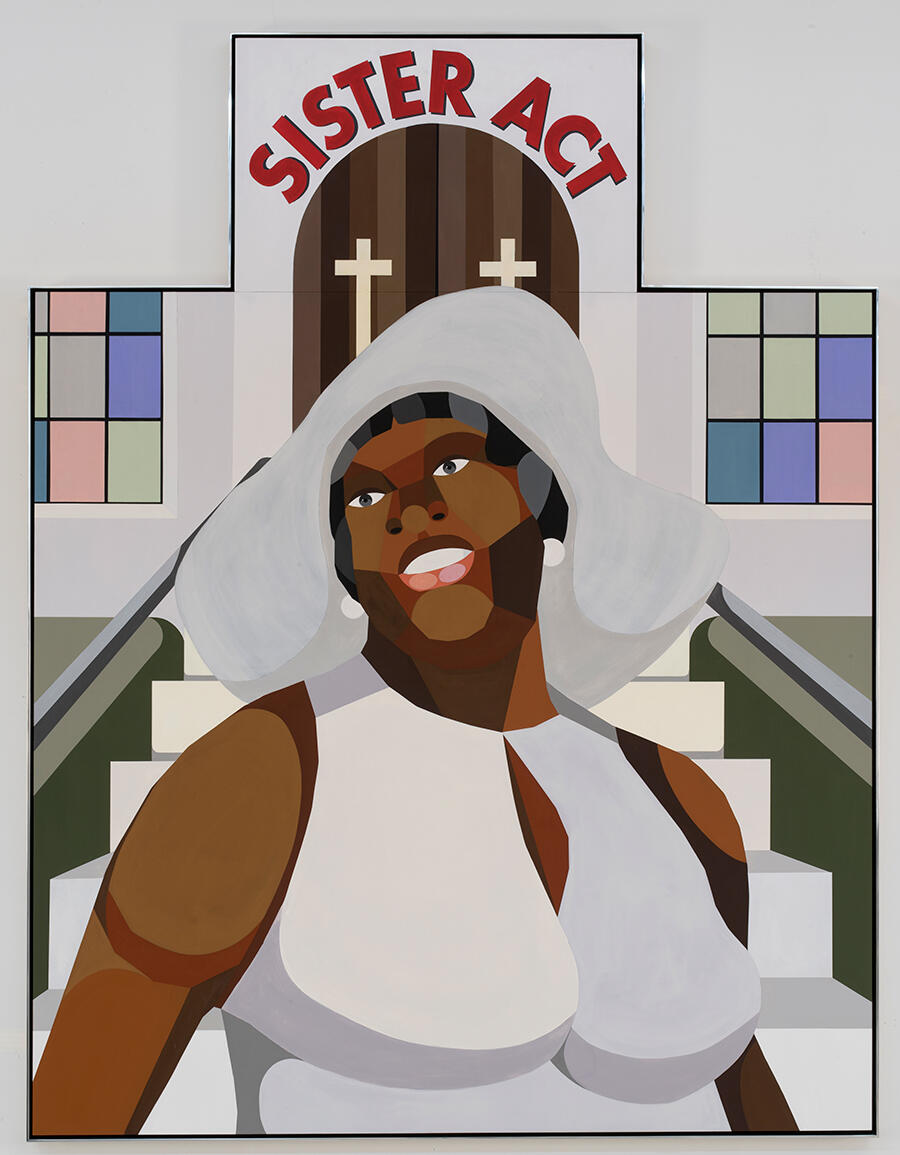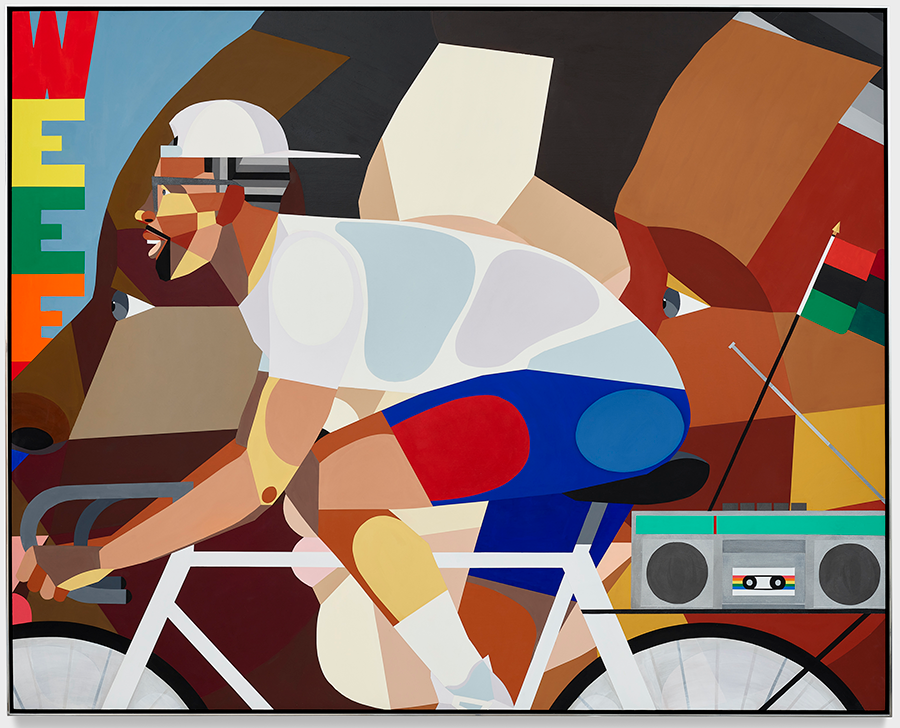Derrick Adams Gives Black Joy the Cinematic Treatment
The artist discusses the politics of representing Black leisure and play in his 'Motion Picture Paintings' series, currently on view at The FLAG Art Foundation, New York
The artist discusses the politics of representing Black leisure and play in his 'Motion Picture Paintings' series, currently on view at The FLAG Art Foundation, New York

When Derrick Adams began representing Black joy on canvas in the 1990s, I was reminded of the uplifting images created by artists of the interwar Harlem renaissance, whose art affirmed the power of ‘racial respect and race pride as an instrument of change, and as a visual embodiment of cultural emancipation1.’ At a time when Black figurative art was often taken to be synonymous with the social realism of Black trauma, Adams’s insistence on creating images of Black refuge, celebration and leisure felt revelatory.
Since then many artists have followed suit. Sola Olulode’s Bed Series (2022–ongoing) is devoted to Black queer couples in states of quiet languor, and projects like Navild Acosta and Fannie Sosa’s Black Power Naps (2019–ongoing) are currently being celebrated at the Museum of Modern Art in New York.
Adams’s solo exhibition at The FLAG Art Foundation, ‘I Can Show You Better Than I Can Tell You’, presents sixteen large-scale works from his new series, 'Motion Picture Paintings' (2020–22). Evoking a range of reference points from cinema, television and popular music in the artist’s hallmark geometric style, the series finds joy in everyday life.

Jane Harris In a 2021 interview with ARTnews, you described this new body of work as ‘a combination of everything I’ve worked on’. Can you elaborate?
Derrick Adams There are a lot of formal elements and style variations from previous work, like the 'Deconstruction Worker' series [2010–ongoing], and the 'Floater' series [2016–2019], that come together in the 'Motion Picture Paintings'. The figures are very geometric but are supported by rounded, more organic shapes. It creates more space and dimension, and allows colour variations to dictate both density and lightness. The spaces are so much more psychological as a result.
The series started during the pandemic, which gave me a lot of time for self-reflection in the absence of studio visits and exhibitions. This FLAG Art show wasn’t even on the radar yet. And that’s what is special about this body of work. It wasn't made for a space or show. It became very personal because of the quietness of making it.

JH That makes me think about the language in this work – the song and movie titles, popular euphemisms and slang words that appear throughout. What motivated that?
DA The text started out as notations of things that came to mind as I was working on the paintings, contemplating their meaning. Eventually I decided to integrate the words into the compositions. I wanted to spark an interest in the relationship between text and image that was less literal and more organic.
JH You draw a lot of inspiration from your imagination, but I heard The Horse You Rode In On [2022] is based on personal references and family photos. Do you consider this work a self-portrait of sorts?
DA Everyone thinks that. I mean, it does resemble me, but the image came from my imagination. It also happens to be my favourite painting in the series because I was able to merge the horse and the human figure in an abstract fashion.

JH In this piece, the words ‘Town & Country’ echo the typography of the magazine of the same name. Were you thinking about class aspiration and self-styling, subjects you’ve dealt with before?
DA For me, it was more about the ideal of being well-rounded. It’s about being able to function in a very metropolitan space of prosperity and then [to go to] the country, which is more relaxed, more casual. The Town & Country figure is a forward-thinking pioneer who can do it all. He could be in town. He could be in the country. He's cool. He's got it.
JH Well, that’s kind of like you.
DA Maybe it is a self-portrait!
JH I find that you’re often drawn to forgotten historical figures. In So Much to Celebrate [2021], for example, you depict a museum party scene in honour of Ellis Haizlip – the producer and host of Soul! [1968–1973], one of the first variety shows on US television that showcased African American arts and culture. Yet you don’t actually make a portrait of him. Why is that?

DA I prefer to invoke curiosity and intrigue through more non-representational elements. It’s like putting crumbs down to create a trail and lure people in. When I was looking at the Green Book [referencing a body of work exhibited under the title ‘Sanctuary’ in 2018, inspired by the Harlem postal worker who created the legendary Black travel guide, The Negro Motorist Green Book, in 1936], I wanted to highlight the publication rather than its creator. And it’s the same thing with Haizlip. I decided to paint an image that evokes a lobby card, or a still from a movie trailer, rather than doing a straight portrait. The context, to me, is what encourages a viewer to seek out more information on Google, for example.
JH You used the word pioneer to describe the figure in The Horse You Rode In On, and I think of you as a pioneer of this idea of Black joy, at least in the realm of contemporary art.
DA Thank you. I consider it a deliberate political act to represent the Black experience in a more complex way, and with a broader sense of humanity that centres the celebratory. As a Black artist, it would’ve been very easy for me to receive even more accolades for highlighting traumatic experiences and to use that as my platform.
JH But you didn’t.

DA No, I doubled down because I really wanted people to know that it's okay to enjoy what you’re looking at. I think it's important to highlight that in the face of adversity there are still moments of normalcy. I'm not making a Hallmark card but evoking emotions which, hopefully, everyone relates to. Like in JUST [2022], anyone can imagine what lounging in a hammock feels like, regardless of what colour the dangling legs are.
JH And what was the ultimate feeling you took away from the experience of making this work?
DA I think that, right now as we have it, people are making work for shows. They're not really making work in the way that the practice of art has always been about: experimentation, meditation and discovery. The best time for artmaking is when you have no shows or obligations, no excuse not to make art. I really encourage younger artists to stay in that space as long as they can, because that’s an amazing space to be in.
1Archibald J. Motley Jr.: The David C. Driskell Series of African American Art Vol IV (2004)
Derrick Adams's 'I Can Show You Better Than I Can Tell You' is on view at The FLAG Art Foundation, New York, until 11 March
Main image: Derrick Adams, Onward and Upward, 2021, acrylic on wood panel, 182 × 487 × 5 cm. Courtesy the artist and LGDR
Thumbnail: Portrait of Derrick Adams in front of his work at the opening of 'I Can Show You Better Than I Can Tell You’. Photograph: Casey Kelbaugh






















